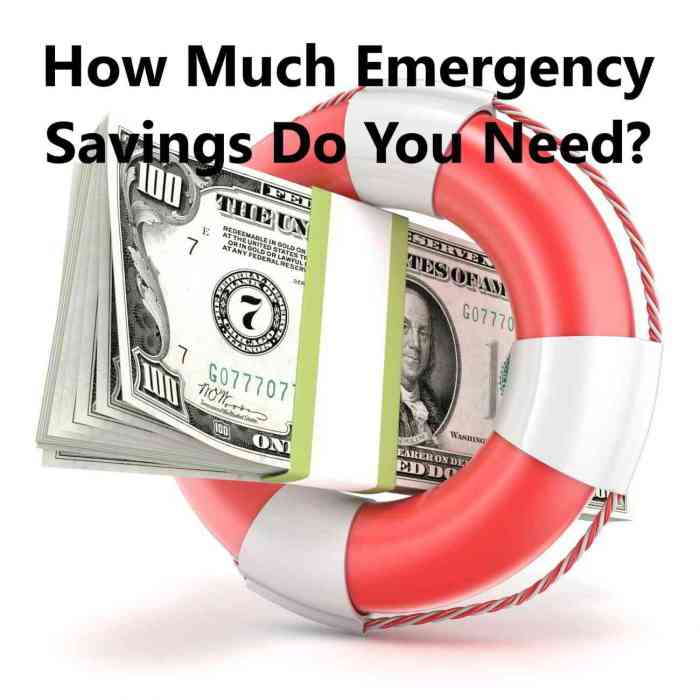In a world full of uncertainties, being prepared for emergencies is key. But what really sets you apart is having dedicated savings specifically for unexpected situations. Let’s dive into the realm of Emergency preparedness savings and uncover the secrets to financial security and peace of mind.
From building your emergency fund to managing and growing it, we’ve got you covered with all the tips and tricks you need to stay one step ahead. Get ready to take control of your finances like never before.
Importance of Emergency Preparedness Savings
Having savings specifically for emergencies is crucial because it provides a financial safety net during unexpected situations. Whether it’s a medical emergency, natural disaster, or job loss, having money set aside can help cover immediate expenses without relying on credit cards or loans.
Real-Life Examples
- During the COVID-19 pandemic, many individuals who had emergency savings were able to weather the financial impact of job loss or reduced hours without major stress. They could cover essential expenses like rent, groceries, and medical bills without going into debt.
- After a natural disaster like a hurricane or wildfire, those with emergency savings could quickly access funds to evacuate, find temporary housing, and replace essential items that were damaged or lost. This allowed them to focus on rebuilding their lives instead of worrying about finances.
- In cases of unexpected medical emergencies, having savings can mean the difference between getting necessary treatment and going into debt. It provides peace of mind knowing that there is money available to cover medical expenses and related costs.
Peace of Mind and Financial Security
Emergency savings not only provide a sense of security but also peace of mind during uncertain times. Knowing that there is a financial cushion in place can reduce stress and anxiety, allowing individuals to focus on addressing the emergency at hand without worrying about the financial implications. It helps to maintain stability and resilience in the face of unexpected challenges.
How to Build an Emergency Fund

Building an emergency fund is crucial for financial security and peace of mind. Here are some steps individuals can take to start building their emergency fund:
Setting a Specific Savings Goal
One of the first steps in building an emergency fund is to set a specific savings goal. Determine how much you want to save for emergencies, whether it’s three months’ worth of expenses or a specific dollar amount.
- Calculate your monthly expenses: List out all your essential expenses such as rent, utilities, groceries, and insurance.
- Determine your savings goal: Decide on the amount you want to save for emergencies based on your monthly expenses and comfort level.
- Break it down: Set smaller milestones to reach your overall savings goal, making it more manageable.
Automating Savings Transfers
Automating your savings transfers can help you consistently contribute to your emergency fund without having to think about it.
Set up automatic transfers from your checking account to your savings account on a regular basis. This ensures that a portion of your income goes directly into your emergency fund.
Traditional Savings Accounts vs. High-Yield Savings Accounts
When it comes to saving for emergencies, it’s important to consider where you keep your funds. Here’s a comparison between traditional savings accounts and high-yield savings accounts:
| Traditional Savings Accounts | High-Yield Savings Accounts |
|---|---|
| Lower interest rates | Higher interest rates |
| Accessible at most banks | May require higher minimum balance |
| FDIC-insured up to $250,000 | FDIC-insured up to $250,000 |
| Convenient for short-term savings | Optimal for long-term savings |
Determining the Right Amount for Emergency Savings
Determining the right amount for emergency savings is crucial in ensuring financial security during unexpected situations. By considering various factors and guidelines, individuals can establish an appropriate target for their emergency fund.
Factors to Consider
- Income Level: The amount of emergency savings needed may vary based on your income level. Higher income earners may require a larger emergency fund to cover expenses.
- Expenses: Consider your monthly expenses, including bills, groceries, and other necessities. Aim to save enough to cover several months of expenses in case of emergencies.
- Debt Obligations: Individuals with high levels of debt may need a larger emergency fund to cover both living expenses and debt payments during emergencies.
Guidelines for Determining the Ideal Size
- 3 to 6 Months of Expenses: A common rule of thumb is to save enough to cover 3 to 6 months’ worth of living expenses. This can provide a financial cushion during unexpected situations like job loss or medical emergencies.
- Specific Goals: Consider any specific financial goals or circumstances that may require additional savings. For example, individuals with dependents may need a larger emergency fund to account for their family’s needs.
- Emergency Fund Calculator: Utilize online tools or calculators to help determine the ideal size of your emergency fund based on your income, expenses, and financial goals.
Personal Circumstances Impact
- Family Size: Larger families may require a larger emergency fund to cover the needs of multiple individuals during emergencies.
- Healthcare Costs: Individuals with chronic illnesses or ongoing medical needs should consider saving more to cover potential healthcare expenses during emergencies.
- Job Stability: Those in industries with high turnover rates or seasonal work may need a larger emergency fund to account for potential gaps in employment.
Managing and Growing Emergency Savings
Managing and growing emergency savings is crucial for financial stability and preparedness. By following some key tips and strategies, you can protect your savings, increase contributions, and access funds when needed without jeopardizing your long-term financial goals.
Protecting Your Emergency Savings
- Avoid unnecessary spending by creating a separate account specifically for emergency funds. This can help prevent you from dipping into these savings for non-emergency expenses.
- Set up automatic transfers from your main account to your emergency fund to ensure consistent contributions without the temptation to skip or reduce deposits.
- Track your spending and budget carefully to identify areas where you can cut back and redirect those funds to your emergency savings.
- Consider using a high-yield savings account or a money market account to earn some interest on your emergency savings while keeping it easily accessible.
Growing Your Emergency Savings
- Increase your contributions gradually over time as your financial situation improves. Aim to save at least 3 to 6 months’ worth of expenses for a solid emergency fund.
- Explore conservative investment options, such as low-risk mutual funds or certificates of deposit, to potentially grow your emergency savings faster than a traditional savings account.
- Reassess your emergency fund amount regularly to ensure it aligns with your current expenses and financial goals. Adjust your contributions accordingly to meet any changes in your financial situation.
Accessing Emergency Funds Responsibly
- Establish clear criteria for when to use your emergency savings, such as job loss, medical emergencies, or unexpected major expenses. Avoid tapping into these funds for non-urgent matters.
- If you need to access your emergency savings, replenish the withdrawn amount as soon as possible to maintain the fund’s integrity and readiness for future emergencies.
- Consider setting up an emergency line of credit or a home equity line of credit as a backup option for accessing funds if your savings fall short in a crisis.










